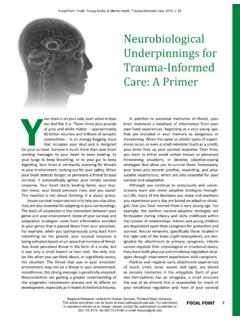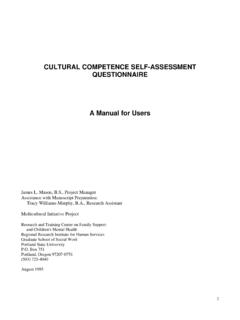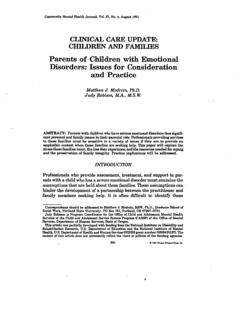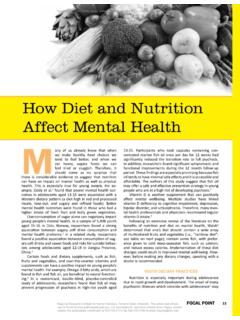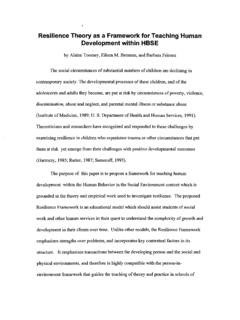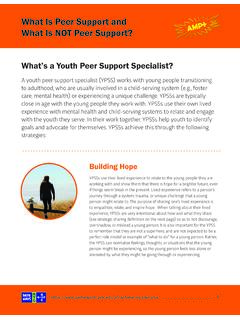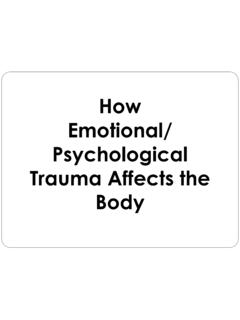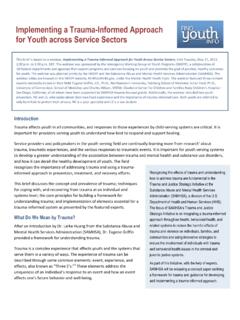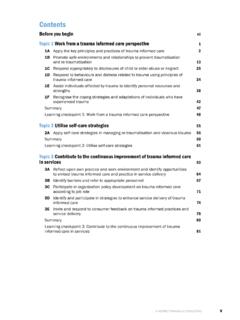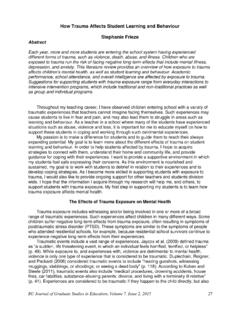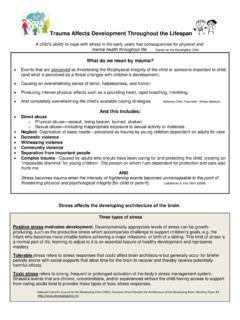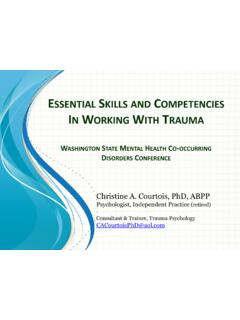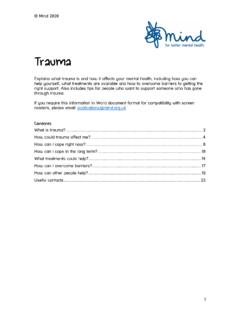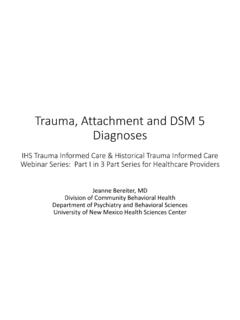Transcription of Understanding Neurobiology of Psychological Trauma
1 This period of development also brings a higher probability of the emergence of mental health disorders,2 and the intensifying of childhood emotional and behavioral Neurosci-entists are working to understand what happens in the brain that increases this vulnerability to mental health challenges. Genetics, social context, and childhood adversity all appear to be significant Chronic stress during childhood, also referred to as early life adversity, has been linked to physical and mental health difficulties during emerging and later Notably, brain areas most involved in responding to traumatic/adverse experiences throughout the lifespan are also the ones that undergo significant developmentally-based changes during adolescence and through the 20s. Given the high prevalence of Trauma exposure among transition-age youth,6 ad-ditional research about this unique neurobio-logical intersection is needed to better inform rapid structural, functional, and neurochemical changes in the brain during early- to mid-adolescence, the pace of neurodevelopment during late adolescence through the 20s is slower and more Changes are concentrated on strengthening neural connections that advance emotional regulation, risk-reward assessment, problem solving, and future planning.
2 Communication between emotional and thinking centers becomes more efficient, providing a greater capacity to think before acting, and con-sider multiple solutions in emotionally-charged Neurobiology of Psychological TraumaTips for Working with Transition-age Youth |By Julie M. Rosenzweig, Pauline Jivanjee, Eileen M. Brennan, Leigh Grover, and Anthony AbshireVisit us at: 201712 The word Trauma is often used in conversa-tion to describe a range of stressful everyday experiences. Yet not all stress changes a person s Neurobiology or the ability to feel emotionally safe. Psychological Trauma , a form of chronic traumatic stress, is felt emotionally and physi-cally, and affects brain circuitry, including alter-ing the stress response system. What is experienced as traumatic psychologically differs across individuals.
3 Psychological Trauma includes the individual s subjective perception of what is traumatic. Key factors that influence this variation include prior Trauma , developmental stage, severity of the Trauma exposure, and the involvement of interpersonal relationships. For example, adolescents are especially sensitive to social stressors from peer influences, compared with children and Additionally, knowl-edge about historical Trauma such as the effects of African Americans experience of slavery and epigenetic transmission informs Understanding of individuals vulnerability to Psychological ,9 Recognizing the neurobiological underpinnings of Psychological Trauma is essential to service providers application of Trauma -informed care & Adaptive Coping StrategiesNeuroplasticity refers to the brain s remarkable adaptableness.
4 Adaptive survival-based coping strategies that emerge in response to adversity are rooted in the biological imperative to survive life-threatening situations and cope with the aftermath of Trauma . Often formed during child-hood, these adaptations are embedded in neural networks, functioning outside of conscious awareness and operating even after the Trauma exposure has ended. The brain stores Trauma memories as part of a protection strategy. When memories quickly (and sometimes frequently) intrude into the present as upsetting thoughts, emotions, sensory memories, bodily sensations, or flashbacks, the original sense of fear, as well as the associated self-protective, survival strate-gies are activated. Adaptive behaviors such as aggression, spacing-out, avoidance, and distrust become automatic responses to the slightest cue of danger.
5 For example, Trauma survivors sensitivity to loud noises, odors, physical proxim-ity to others, and touch can instantaneously activate adaptive reactions. Neuroplasticity is key to healing and recovering from Psychological Trauma . The mind and body can learn to feel safe again. Updated adaptive strategies develop when the threat is not immi-nent and safe relationships are available. When service providers see traumatic stress responses as neurobiologically-embedded coping adapta-tions rather than as symptoms of mental health disorders, or intentional disruptive behaviors, they can help individuals to revise these coping strategies to better meet their current needs. Threat Assessment System for Survival The stress-response system called the hypothal-amus-pituitary-adrenal (HPA) axis is initiated by actual or perceived threat.
6 The amygdala, as the first responder, receives information from the thalamus, (gatekeeper of incoming sensory information) which is rapidly screened for danger, with the potential of activating the pituitary (gland that releases hormones). The Trauma s Neurobiological Signature3 Figure 1. The Brainhippocampal memory system assists in this assessment by providing the amygdala with information from its database of past threats. In tandem with the prefrontal cortex (PFC), (critical for emotional regulation and decision-making), the hippocampi (memory storage structures) are also essential in deactivating the HPA axis when threat subsides. Once the amygdala sounds the alarm, the HPA axis releases a cascade of chemicals and hor-mones, mobilizing the individual to survive the threat by fighting or fleeing. When mobilizing is not possible, then survival through immobilizing kicks on, significantly slowing the individual s life sustaining systems ( heart rate, breathing).
7 These reactions are immediate, bypassing any thoughtful decision-making. Typically, when the real or perceived danger passes, the HPA axis returns to its pre-threat status. However, when Trauma is ongoing, such as chronic abuse or neglect in childhood, the HPA axis continues to flood the body with the stress hormone cortisol from the adrenal glands (producer of several key hormones). This over-production creates a state of toxic stress within the body that changes the physical structure and function of the amygdalae, hippocampi and PFC. Although the brain s intention is to promote a higher possibility of survival through a state of constant vigilance, other capacities are compro-mised, such as thinking clearly and managing feelings. The high levels of cortisol, and inability to emotionally regulate heighten the probability of the youth engaging in risky behaviors and of the onset of physical health who have experienced childhood adversity, or have current toxic stress, are often stuck in fight or flight mode, feeling jumpy, anxious, or hyper-vigilant; some can be stuck in shutdown, feeling disconnected, foggy, numb, or unfocused.
8 These feelings, the behaviors that coincide, and the reactions of others are confus-ing and disrupt functioning in daily activities and relationships. (Illustration by Halorie Walker-Sloss)4 Relational Safety is KeyPeople are neurobiologically hardwired to be emotionally connected with others. When this biological imperative to feel secure in early attachments is disrupted through traumatic experiences, relationships are likely to generate a sense of fear, or anxiety, rather than a sense of safety and comfort. Youth receiving services have often experienced their earliest relationships with caregivers as unpredictable and Communication that facilitates the attachment process during infancy is primarily through non-verbal, sensory-based signals, such as sounds, touches, smells, tastes, and eye contact. How the caregiver attunes to and co-regulates the baby s emotional and physiological states teaches the infant how to trust and participate in relationships.
9 Whether these early relational experiences are comforting or frightening to the infant, a neurobiological imprint is made, a guidebook of sorts, for navigating relationships. Pre-verbal memories are stored and re-membered quite differently compared with memories from toddlerhood and beyond. Earliest memories are held in the amygdala s implicit memory system and are recorded without narrative, or a sense of self, time, or place. These memories are sensory-based, such Co-regulation & Strengthening Resilience Capacity Share about the brain s natural abilities to adapt and promote survival during traumatic experiences. Support youth in sharing about their current coping behaviors, and assigning new meaning through a survival promotion lens. Help co-construct modifications in existing coping strategies and brainstorm new strategies, especially ones that include healthy relationships.
10 Increase your awareness of the early signs of mobilization responses (fight & flight) and immobilization responses (shut-down) in youth. Observe and co-regulate. Talk with youth about the stress response system; guiding them in noticing emotional and physical sensations during activation. Learn to recognize implicit sensory activation cues that youth may encounter ( sounds/noises, smells/scents, touch/proximity, time of day/year, celebrations). Minimize exposure when possible. Stay compassionate and curious when activation smells, temperatures, touches, tastes, and sounds, often associated with the caregivers. At approximately 2 years of age, the hippocampal explicit memory system comes online and begins recording autobiographically. Recall of explicit memories typically begins around the age of 5 years and includes images and narratives with a sense of self, time, and is the implicit memory system that is also the record keeper of Psychological Trauma throughout the lifespan.
